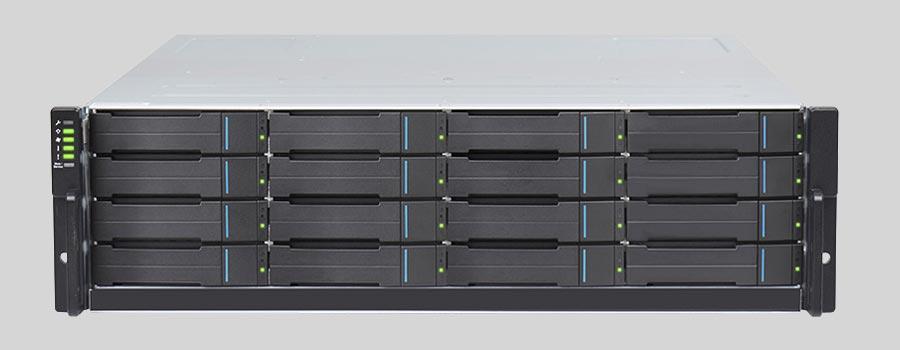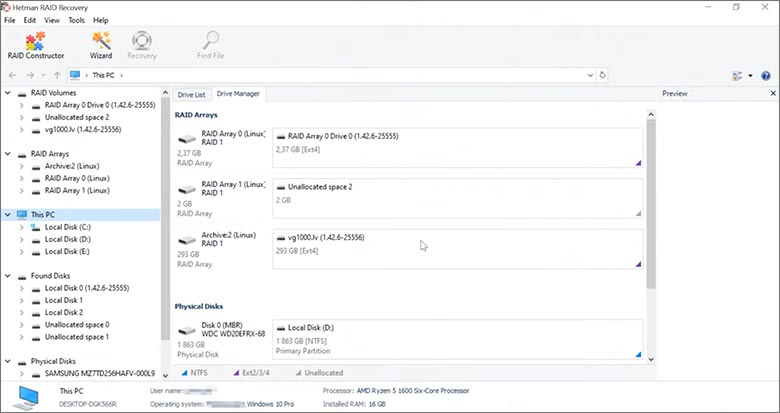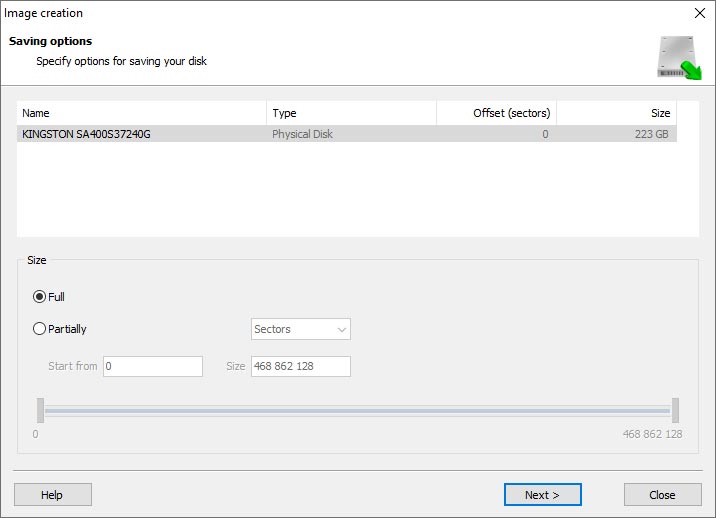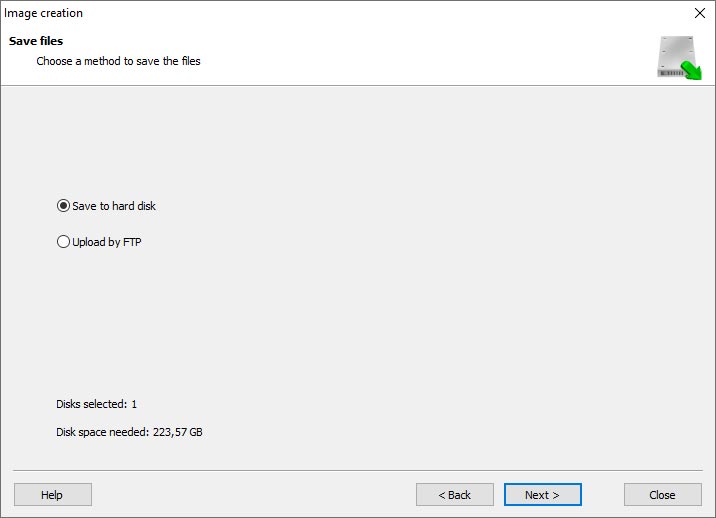
- Why Regular Data Recovery Tools Can’t Restore Files from RAID
- Key Information About the NAS Infortrend EonStor GS 3016
- How to Remove Hard Disks from Your NAS and Connect Them to a PC
Why Regular Data Recovery Tools Can’t Restore Files from RAID
Conventional hard drives store user data by writing it sequentially across the disk surface, which means an entire file is typically located on a single drive. In contrast, when data is written to a RAID array, each file is split into multiple fragments. These fragments are then distributed and written in sequence across all the drives in the array. Depending on the configuration, fragment sizes can range from 2 KB to 2 MB, so every file is physically stored across several disks at once.
This approach significantly increases read and write performance — after all, writing two halves of a 1 GB file to two drives simultaneously is much faster than writing the full 1 GB to a single disk. However, this same mechanism makes file recovery far more complex.
Different RAID levels use different methods to distribute and protect data. On top of that, manufacturers like Infortrend often add their own proprietary structures and variations. As a result, data can be written to disks in many different formats, and each requires a specific approach during recovery.
How can hardware failure lead to data loss in NAS Infortrend EonStor GS 3016 devices?
Hardware failure in NAS Infortrend EonStor GS 3016 devices can lead to data loss in several ways:
- Disk Drive Failure: NAS devices typically use multiple disk drives to store data. If one or more drives fail, it can result in data loss or corruption. This can happen due to mechanical issues, manufacturing defects, or wear and tear over time.
- Power Supply Failure: A faulty power supply can cause sudden power outages or fluctuations, which can lead to data loss or corruption in the NAS device. Power surges or spikes can damage the internal components and storage drives, resulting in data loss.
- Controller Failure: The controller in a NAS device manages the data flow between the drives and the network. If the controller fails, it can cause data access issues or complete data loss. This can occur due to hardware malfunctions, firmware bugs, or electrical problems.
- RAID Array Failure: NAS devices often use RAID (Redundant Array of Independent Disks) technology to provide data redundancy and protection against drive failures. However, if multiple drives fail simultaneously or within a short period, it can lead to a complete RAID array failure and data loss.
- Overheating: Inadequate cooling or ventilation in the NAS device can cause overheating, which can damage the internal components, including the storage drives. Overheating can result from a faulty fan, clogged air vents, or prolonged high usage. When the drives fail due to overheating, data loss can occur.
- Natural Disasters or Accidents: Hardware failures can also be caused by natural disasters such as floods, fires, or earthquakes, or accidental events like drops, impacts, or spills. These incidents can physically damage the NAS device and its components, leading to data loss.
To minimize the risk of data loss due to hardware failure, it is crucial to regularly back up the data stored on the NAS device to an external location or secondary storage system. Additionally, implementing a RAID configuration with redundancy and regularly monitoring the device's health can help detect and mitigate hardware issues before they lead to data loss.
How to Remove Hard Disks from Your NAS and Connect Them to a PC
Although the NAS EonStor GS 3016 can be accessed over the network, you still need to remove its hard disks and connect them directly to a Windows PC. Only then can the recovery software properly scan and analyze the drives. Follow these steps:
-
Power off the NAS and disconnect it from the power source.
WARNING! Before removing any drives, carefully read the device manual. Improper actions may damage both the NAS enclosure and the hard disks in the RAID array.
-
Remove the hard disks one by one, gently sliding each drive out of its slot. Remember that hard disks are highly sensitive: any impact or drop can cause serious physical damage.
-
Label each hard disk according to its position inside the NAS. The order of the drives is crucial for correct RAID reconstruction.
-
Connect the drives to your computer. In this video, we explain which ports you can use to connect hard disks and what to do if your PC does not have enough free connectors.
Go to view
Step-by-Step Data Recovery with Hetman RAID Recovery

This program restores data from damaged RAID arrays and is fully compatible with Infortrend EonStor GS 3016. Each hard disk in the array contains technical metadata describing how files were written. When launched, Hetman RAID Recovery analyzes this metadata, automatically reconstructs the damaged array, and provides access to its contents. After that, you can browse the recovered disk and save your files. The program can also restore files that were accidentally deleted from the network drive.

How to recover data from a Infortrend
EonStor GS 3016 has 16 HDD slots, and it supports the following array types:
- RAID 0;
- RAID 1;
- RAID 5;
- RAID 6;
- RAID 50;
- RAID 60;
- JBOD;
NAS supports:
- exFAT, VFAT, FAT 12 / 16 / 32;
- NTFS / ReFS;
- APFS / HFS+;
- Ext2 / 3 / 4 / ReiserFS / XFS / UFS / ZFS / Btrfs;
- VMFS / HikvisionFS;
How to Safely Recover Data from Disk Images
This utility allows you to create a complete copy of a disk and work with the disk image instead of the physical drive. This approach helps protect your data from:
- Overwriting during the recovery process;
- Additional data loss caused by bad sectors;
- User errors.
To create a disk image, follow these steps:
-
Ensure you have enough free space to store the image. Its size will typically match the size of the original disk.
-
In the main window, select the target disk and choose Tools - Save Disk. You can also select multiple disks if needed.
-
When the Image Creation Wizard opens, select whether you want to save the entire disk or only a specific region. Adjust the settings and click Next.

-
Choose the directory where the image will be saved. You may select any available disk connected to your PC or upload the image via FTP.

Where Are the User’s Files Actually Stored?
The Infortrend EonStor GS 3016 network-attached storage keeps OS Linux operating system files on a separate RAID 1 (mirrored) array. Usually, all NAS systems create several volumes on every hard disk, and the first of them takes up to 2 Gb of space. This is where operating system files are stored. Other volumes are united into a RAID array where user’s data is written.
RAID Recovery Software: Detailed Comparison
| Product | Operating system | RAID controller support | Supported file systems | Virtual RAID controller support | Data recovery from damaged RAID | File preview |
|---|---|---|---|---|---|---|
| Hetman RAID Recovery | Windows, Linux, MacOS | Yes, over 100 controllers | FAT, exFAT, NTFS, ReFS, APFS, HFS+, Ext4, Ext3, Ext2, ReiserFS, Btrfs, VMFS, Hikvision, XFS, UFS, ZFS | Yes | Yes | Yes |
| DiskInternals RAID Recovery | Windows | Yes, over 10 controllers | FAT, NTFS, Ext2/3/4, HFS+ | No | Yes | Yes |
| R-Studio | Windows, Mac, Linux | Yes, over 20 controllers | FAT, NTFS, Ext2/3/4, HFS+ | Yes | Yes | Yes |
| UFS Explorer RAID Recovery | Windows, Mac, Linux | Yes, over 100 controllers | FAT, NTFS, Ext2/3/4, HFS+ | Yes | Yes | Yes |
| EaseUS Data Recovery | Windows | Yes, over 20 controllers | FAT, NTFS, Ext2/3/4, HFS+ | No | Yes | Yes |
| ReclaiMe Free RAID Recovery | Windows | Yes, over 100 controllers | FAT, NTFS, Ext2/3/4, HFS+ | Yes | Yes | Yes |




To determine whether data recovery from a NAS Infortrend EonStor GS 3016 device can be performed without voiding the warranty, it is recommended to consult the specific terms and conditions of the warranty provided by Infortrend.
Typically, opening or tampering with the hardware of a device can void the warranty. However, some manufacturers may allow data recovery services to be performed by authorized personnel without voiding the warranty. It is essential to check the warranty documentation or contact Infortrend directly to confirm their policy on data recovery and warranty coverage.